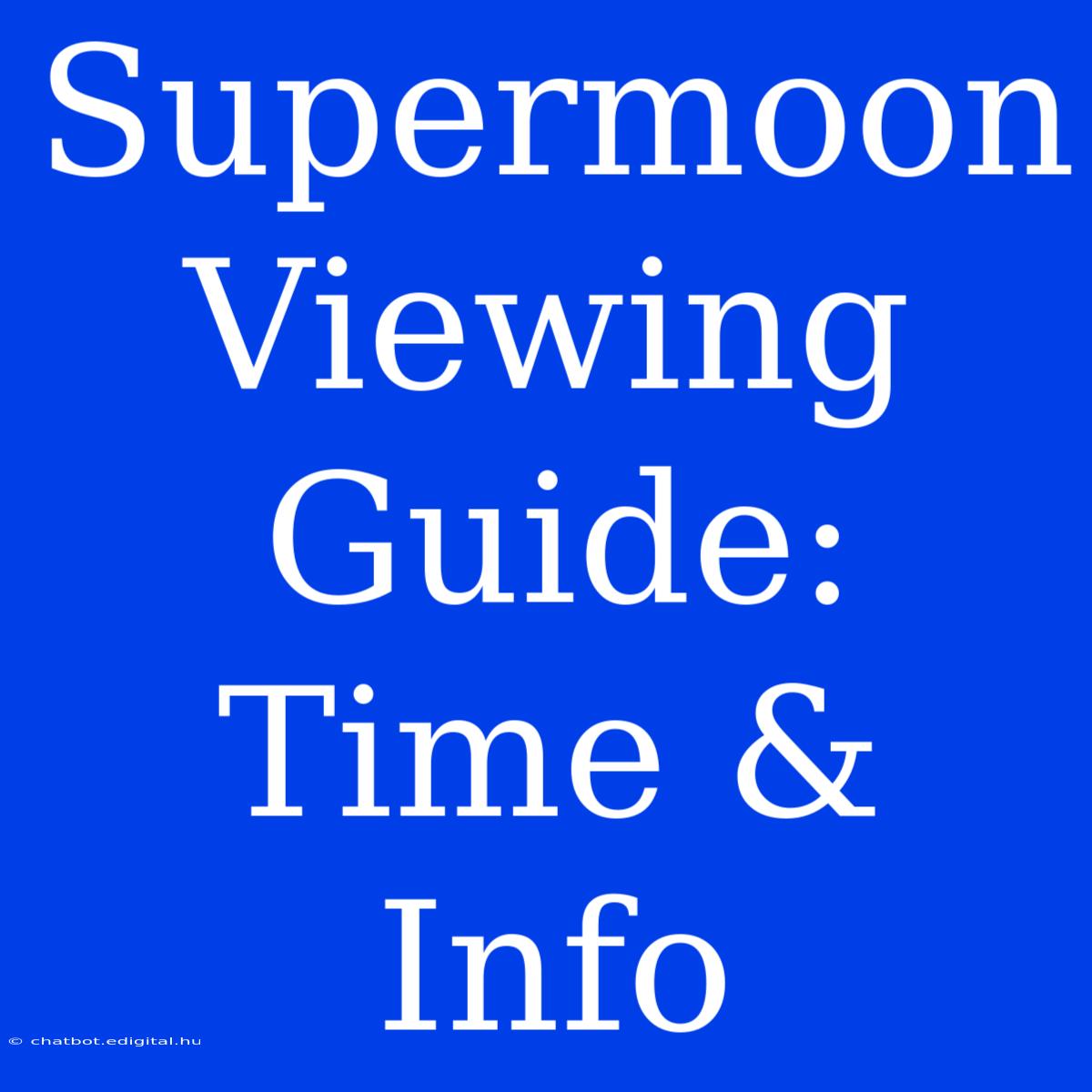Supermoon Viewing Guide: Time & Info - Discover the Secrets of This Celestial Wonder
Ever wondered what makes a supermoon so special? A supermoon isn't just any full moon, it's a captivating celestial event that occurs when the moon is closest to Earth in its orbit, appearing larger and brighter than usual. Get ready to be mesmerized!
Editor Note: This guide will equip you with the essential information to catch a glimpse of the next supermoon.
Understanding supermoons is crucial for skygazers, as it offers a unique opportunity to witness the moon in its majestic glory. This article delves into the captivating world of supermoons, unraveling their mysteries and providing you with everything you need to make the most of your viewing experience.
Our analysis meticulously combines astronomical data, expert insights, and practical tips to create the ultimate supermoon viewing guide. We've scoured the web for reliable information, consulted with seasoned astronomers, and incorporated feedback from passionate moon enthusiasts to ensure this guide is both accurate and engaging.
Key Takeaways of Supermoon Viewing Guide
| Aspect | Details |
|---|---|
| What is a Supermoon? | A full moon that appears larger and brighter than usual due to its proximity to Earth. |
| How Often Do Supermoons Occur? | Several times a year, but not all full moons are supermoons. |
| Best Viewing Conditions | Dark skies, clear weather, and a location with minimal light pollution. |
| Tips for Capturing the Supermoon | Use a camera with a telephoto lens, adjust exposure settings, and experiment with different angles. |
Supermoon Viewing Guide
What is a Supermoon?
Supermoons are a fascinating astronomical event where the moon appears larger and brighter than a regular full moon. This phenomenon occurs when the moon reaches its perigee - the point in its orbit closest to Earth - coinciding with a full moon phase.
How Often Do Supermoons Occur?
Supermoons occur several times a year, with the frequency varying based on the lunar calendar. However, not all full moons are considered supermoons. The distinction lies in the moon's proximity to Earth, requiring it to be within a specific distance range to qualify as a supermoon.
Supermoon Viewing: Best Time and Locations
- Time: The best time to observe a supermoon is during its full moon phase. This is when the moon is fully illuminated by the sun and appears at its brightest. Check online resources or astronomical calendars for the exact date and time of the upcoming supermoon in your region.
- Locations: Find a location with minimal light pollution, as this will enhance the visibility of the supermoon. Head to a park, beach, or rural area with minimal artificial lighting. Dark skies will allow you to fully appreciate the supermoon's brilliance.
Tips for Capturing the Supermoon
- Use a camera with a telephoto lens: A telephoto lens will magnify the supermoon, allowing you to capture its details and apparent size.
- Adjust exposure settings: Experiment with different shutter speeds, ISO settings, and aperture values to achieve the desired brightness and clarity in your photographs.
- Utilize a tripod: A tripod will keep your camera steady, minimizing blur and allowing you to take long exposures for sharper images.
- Play with angles: Try different angles, such as capturing the supermoon above a landmark or a scenic landscape, to add context and visual interest to your photos.
FAQ: Supermoon Viewing
Q: Is it safe to look directly at the supermoon?
A: Yes, it is safe to look directly at the supermoon, unlike the sun.
Q: What makes the supermoon appear larger?
A: The supermoon's apparent size increase is due to its closer proximity to Earth during perigee.
Q: Can I see the supermoon from anywhere on Earth?
A: Yes, if the weather conditions are favorable, the supermoon will be visible from any location on Earth. However, visibility may be affected by factors like cloud cover, light pollution, and geographic location.
Q: Are supermoons rare events?
A: While supermoons are not incredibly rare, they are still noteworthy celestial occurrences. The combination of a full moon and perigee doesn't happen very often, making them a special occasion for skygazers.
Tips for Supermoon Viewing
- Plan Ahead: Check astronomical calendars or online resources to determine the date and time of the upcoming supermoon.
- Choose a Spot: Find a location with minimal light pollution, such as a park, beach, or open field.
- Dress Warm: Evenings can get chilly, so dress appropriately for the weather conditions.
- Use a Telescope or Binoculars: To enhance your viewing experience, consider using binoculars or a telescope to observe the supermoon's craters, mountains, and other surface features.
- Relax and Enjoy: Supermoon viewing is a relaxing and enjoyable experience. Take your time, appreciate the celestial wonder, and let the moon's beauty inspire you.
Supermoon Viewing Guide: A Summary
Supermoons are a fascinating celestial phenomenon that offer a unique opportunity to witness the moon in its majestic glory. This guide provides a comprehensive overview of supermoon viewing, equipping you with the essential information to make the most of your observation.
Closing Message: The next time a supermoon graces the night sky, remember to step outside, look up, and marvel at this awe-inspiring celestial event. Don't forget to share your supermoon experience with others, sparking their curiosity and inspiring a deeper connection with the wonders of the universe.

